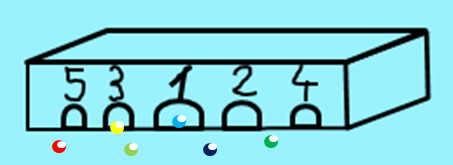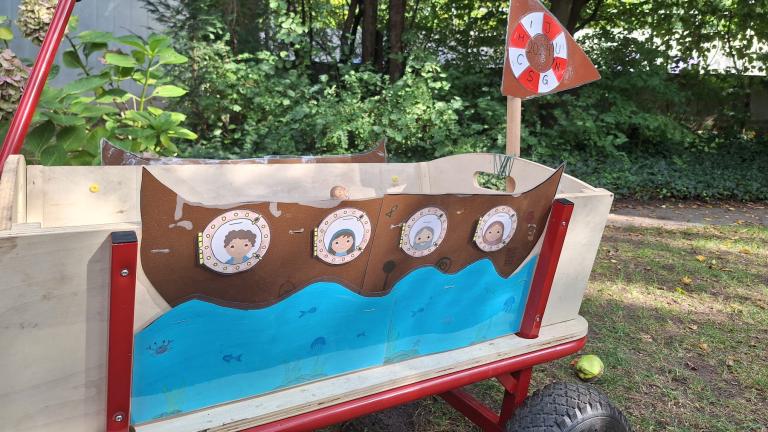… oder Schusser, Klicker etc. Über 100 Namen gibt es allein im deutschsprachigen Raum für dieses Spiel und mindestens ebenso viele Spiele.
Where have the Chlüre / marbles gone?
You can still find them in the toy shops, and particularly beautiful specimens can be seen from time to time in the candy jar on a bookshelf. In any case, children who play with chocolates have become rare and only a few still know what these colourful glass balls are for.
Our grandparents remember
In those days, not every nook and cranny was paved, not every corner used for parking. It was easy to find a spot on the street where you could "shoot" undisturbed. All you had to do was drill a hole in the ground with the heel of your shoe and you were ready to go. The road belonged to the residents and not to the traffic. Most importantly, the street belonged to the children. The marble game was a spring game: it came, charmed all the children without exception, and disappeared as mysteriously as it had come.
This is how the ancient Romans played "Marbles and nuts are as precious to Roman children as gold is to adults," the Roman writer Augustine once opined. And he was right, for the game of marbles (or nuts, in which nuts were shot instead of marbles) was one of the most popular children's games in the time of the ancient Romans. Archaeologists have unearthed countless Roman marbles during excavations, which can be seen today in the display cases of museums. There were stone marbles, clay marbles and glass marbles as we know them today. Marbles may be the oldest game in the world.
Where we play
We can play outside, in the garden, in a compound, at the playground, in the street, in the backyard, and in the schoolyard. If there is no possibility to play outdoors at all, either because it is pouring with rain or because playing in the street is too dangerous, you still don't have to give up clicking. Many games can be played just as well in the room or in the ant room. Experts throw or roll the balls in simple to complicated throwing techniques (joint throw, thumb shot, flicking). In the Ameisli, however, the focus is on the joy of the game, not the technique. Let's go!
Pungitan
This game requires at least two players and one marble and one target marble each. In the Philippines, people know this marble game, which used to be played with small round shells. For this, a circle of 60 cm diameter is drawn on the floor (or wrapping paper), in the middle of which a tiny ring of 2 cm is made. The first player places his marble on the edge of the large circle and tries to aim his throwing ball at a marble that has been placed in the mini-circle. If he hits it, he scores 1 point. If he can even hit it with his shot from both the small and the large circle, then he scores 5 points. If he misses, then he goes out empty. The one who has the most points after several rounds is the winner.
Ratemurmelspiel Par-Inpar (Ancient Rome)
Any number of marbles are needed. The game is played in pairs. Par-Inpar was very popular with the Roman children. For this, an ant holds some marbles hidden in his fist and asks his comrades to guess whether it is an even or an odd number. If the opponent guesses correctly, he gets a point, if he guesses wrong, the point goes to the other person. The leader can help with the writing down and help with the younger Ameisli with even and odd numbers. Both players take turns hiding and guessing until someone has reached 10 points. He may collect a marble from his teammate as a reward. This game is better suited for older Ameisli. In the same time, the younger Ameisli can try an easier game.
Pit marble game Kanju (India)
10 - 12 antli each need a marble. a throwing line is drawn 1 - 5 m from a 10 cm hole (depending on difficulty and age). Each ant in turn aims at this hole. The one that hits it first wins and is eliminated in the following rounds. The others continue to play, with each one that hits also being eliminated. This continues until only one player remains. She has lost and must hop on one leg from the hole to the throwing line as a penalty. Variation: on the second pass (or for eliminated players) the throwing line is further from the hole.
Bounce
10 - 12 Ameisli need one marble each. From a line, marbles are thrown against a wall. If a bouncing marble hits another, the shooter owns all the marbles lying on the ground.
Variations:
- the marble must hit directly as it falls
- it is also sufficient if it touches another one as it rolls away
Torch
10 - 12 Ameisli need at least two balls. Gateways of different widths have been cut into a cardboard box. Each archway is headed with a score - the smaller the entrance, the higher the score. Who reaches the highest total in 10 attempts? The leader helps with adding up. Older Ameisli can be of assistance.
Mumble maze
A maze can be made from cardboard tubes, hoses, water wheels, boxes and bell stairs with a little imagination and glue. If different exits are possible or if the marble lands last in a level with a point setting, it's a game of chance. I hope that you will include a marble game in one of your next ant-lining afternoons. Have fun and good luck
- Se connecter ou s'inscrire pour publier un commentaire
Le contenu peut être traduit automatiquement. Aide-nous à améliorer la qualité de la traduction en la modifiant !




